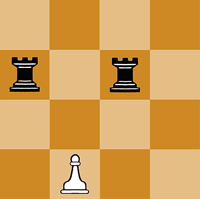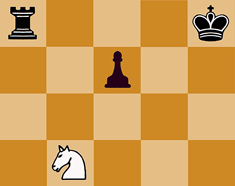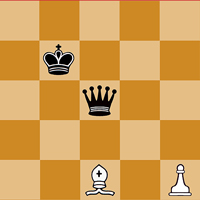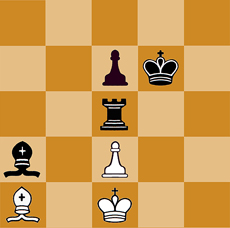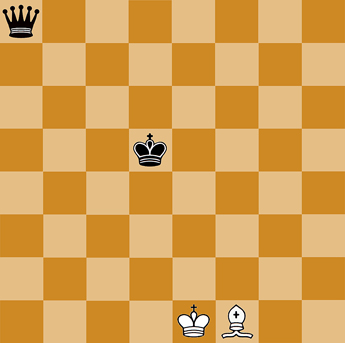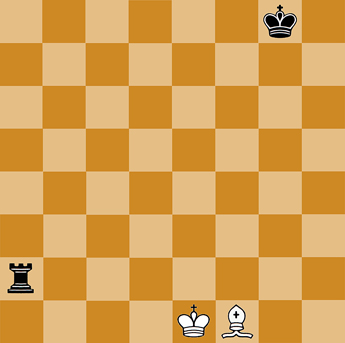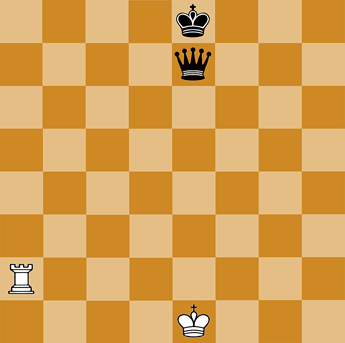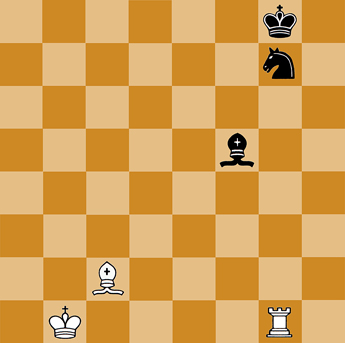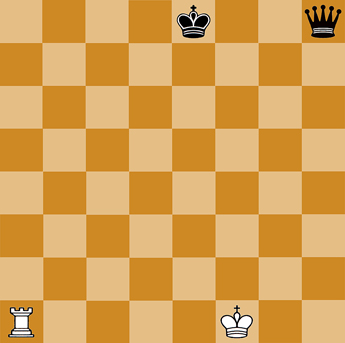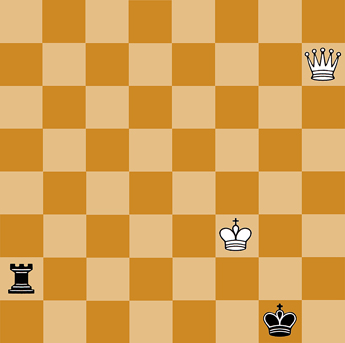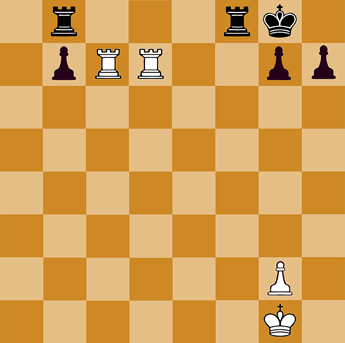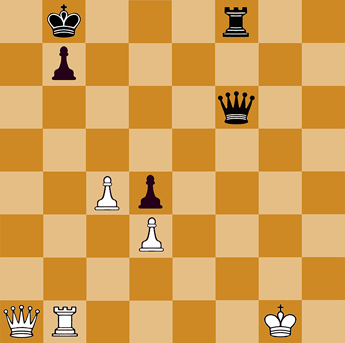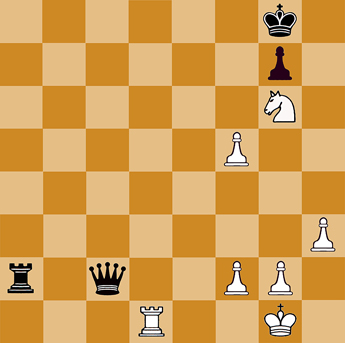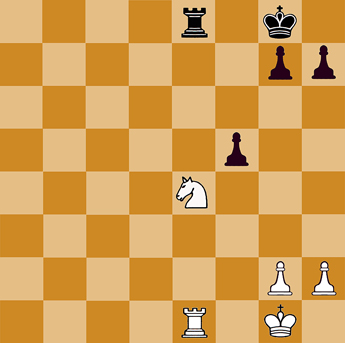|
After having investigated, by logical processes, those fairly simple positions which make up the elements of the End Game, we now turn to procedures which rely not on logic but on judgment. Our first task is to obtain an insight into the effect of the men. What power do the pieces have, in aiding in the execution of a well conceived plan? 1. The men have several effects, they give check, they capture pieces and they obstruct hostile forces, thus guarding their King and each other. They restrict the hostile King in his degree of movement, and thus aid in a checkmate. The player should therefore try to obtain a fairly accurate estimate of what he might expect his pieces to do on the average, and of how much work he might hope to get out of them when at their best. If he knows little of the game his knowledge of these values will be small and as he advances in skill and experience his knowledge of these values will increase, but no matter how much or how little he may know of chess the method of trying in someway to fix these values is possible. It is a good method for the master and beginner, and is applicable to any game and by anyone. 2. To begin with the weakest man, the pawn. As long as it is not promoted it can, at its best, disrupt two pieces at once, the resulting pattern as the diagram shows is called a “fork.”
The White pawn advances to Kt6 and forks the two Black rooks, which have difficulty in moving themselves from the impending assault. 3. A Kt may at one and the same time attack and menace many pieces, since the range of its movements may extent to eight squares, but it will do very well if it attacks two heavily armed hostile men simultaneously, as in this further example of “the fork.”
The White Kt by capturing the QBP gives check and menaces the Black R at the same time. 4. The B not only can attack several men at the same time but has also the advantage of “pinning” one of the enemy’s men.
The White B moves to Q5 where he is supported by the White Pawn. If Q captures B the P recaptures. The Q is unable to make any different move, because the Black K must not be exposed.
The Black Rook is pinned. Whatever Black moves he cannot avoid losing his castle. For instance, 1 …, B-K3; 2 K-Kt5, any move; 3 B x R. A double attack by the B is all the stronger if the K is involved.
The B goes to Kt2 ch, and wins the Q, in a 2 player chess game.
The White B moves to B4 ch, and wins the R. 5. A Castle also can pin adverse men.
White is in check. He moves R-K2, thus obstructing the Queen and subjecting it to a partial pin, and allowing the R to take the Queen.
White plays B x B. The Black Kt cannot recapture because he is pinned by the R. The R also can win pieces by checking.
White by playing R-R8 ch, wins the Q and the 2 player chess game. 6. The R and more so the Q are able to attack two or more pieces at the same time.
The Q wins the R by Q-Kt8ch.
Black to play either moves the K: 1 …, K-KB8; 2 Q-KR3 wins, or else moves the R away from the protection of his K and exposes it to danger. 1 …, R-QR7; 2 Q-Kt5 ch., K-R8; 3 Q-R6 ch., K-Kt8; 4 Q-Kt6 ch., K-R7; 5 Q-R7 ch., K-Kt8; 6 Q-Kt8 ch., wins the R.
The White Rooks having been doubled on the seventh rank, attack all the Black pawns. They also threaten to checkmate in three moves How? At the very least Black loses all of his Pawns: 1 …, R-B3; 2 R x P ch., K-B1; 3 R x RP, K-K1; 4 R x P. 7. The K has considerable flexibility; an example of a double attack by the K was given above (see previous page). The main function of the K however, is to seek security, because he otherwise serves as a target for attack. It is fairly easy to checkmate a King who has been inadvertently abandoned by his men on a 2 player chess game, provided the attacker has a very strong piece or two supported by minor pieces at his disposal. But considerably more difficulty is experienced when the King is protected by Pawns.
Black to play, mates quickly, and also if it is Whites move it is too late to save the K. Say White plays 1 R-Kt2, Q-B6; 2 R-Kt2, Q-K6 ch.; 3 K-R1, R-R1 ch.; 4 R-R2, Q-B6 ch,; 5 K-Kt1, R-Kt1 ch.; 6 R-Kt2, Q x R mate. Or again; 2 Q-K1, R-Kt1 ch.; 3 K-R2, R-R1 ch.; 4 K-Kt1, R-R8 mate.
White to play. Black would win by force of numbers if his K were sufficiently protected. As it is White mates in two moves; 1. R-Q8ch K-R22. R-KR8 mates, or 1 …, K-B22 R-KB8 mates
Black thinks that the Kt cannot escape because if moved it exposes the R to capture, but it is not so, a check intervenes: 1 Kt-B6 ch., P x Kt; 2 R x R ch, and wins. The variety of attacks against the K is exceedingly large. The student should familiarize himself with a few instances and experiment with them. Here are a few simple exercises that l should recommend; White: K on KKt2, R on K1, Kt on KB3, P on K5. Black: K on KR2, R on KB3, B on Q3, P on KKt2 and KR3. Black, to play, saves his pieces threatened by the fork. White: K on KKt1, Q on QR7, Kt on K4, P on QB2, Q3 and KKt2. Black: K on K1, Q on KB3, R on Q3, P on KB2.
44 Black, to play, saves his Queen and R attacked by the Kt. White: K on QB1, R on QR7 and QKt7. Black: K on K1, Q on QB1, P on QB6. White, to play, wins by R-KR7, threatening mate. White: K on KB1, Q on KB6, R on Q2, P on KR6. Black: K on KKt1, Q on Q1, R on K2, P on KB2, KKt3 and KR2. Black, to play, wins by R-K8 ch. White: K on KKt1, Q on QR7, R on K1, Kt on K4. Black: K on K1, Q on Q5, Rs on Q3 and Q1, B on KB1. White, to play, wins. By what move? White: K on KKt1, Q on QKt8, Kt on QKt5, P on KB2, KKt3, KR2. Black: K on KB2, Q on KB6, B on KR6, P's on Q3 and KKt2. White, to play, wins by Q-Kt7 ch. Why?
|
